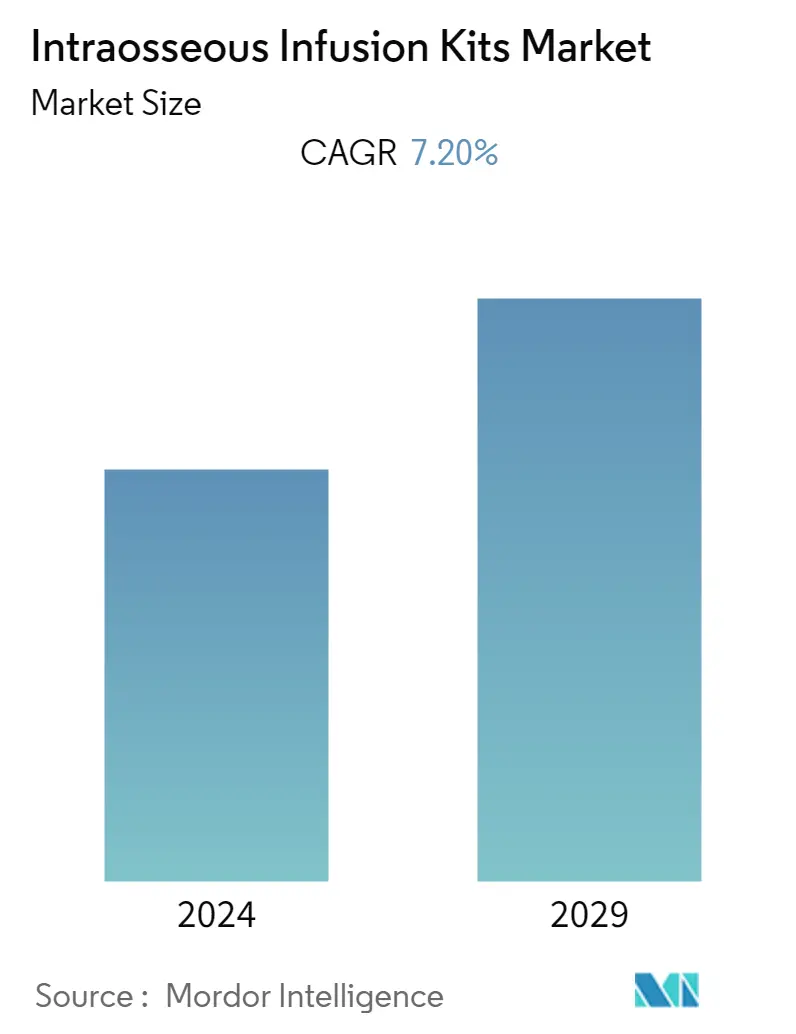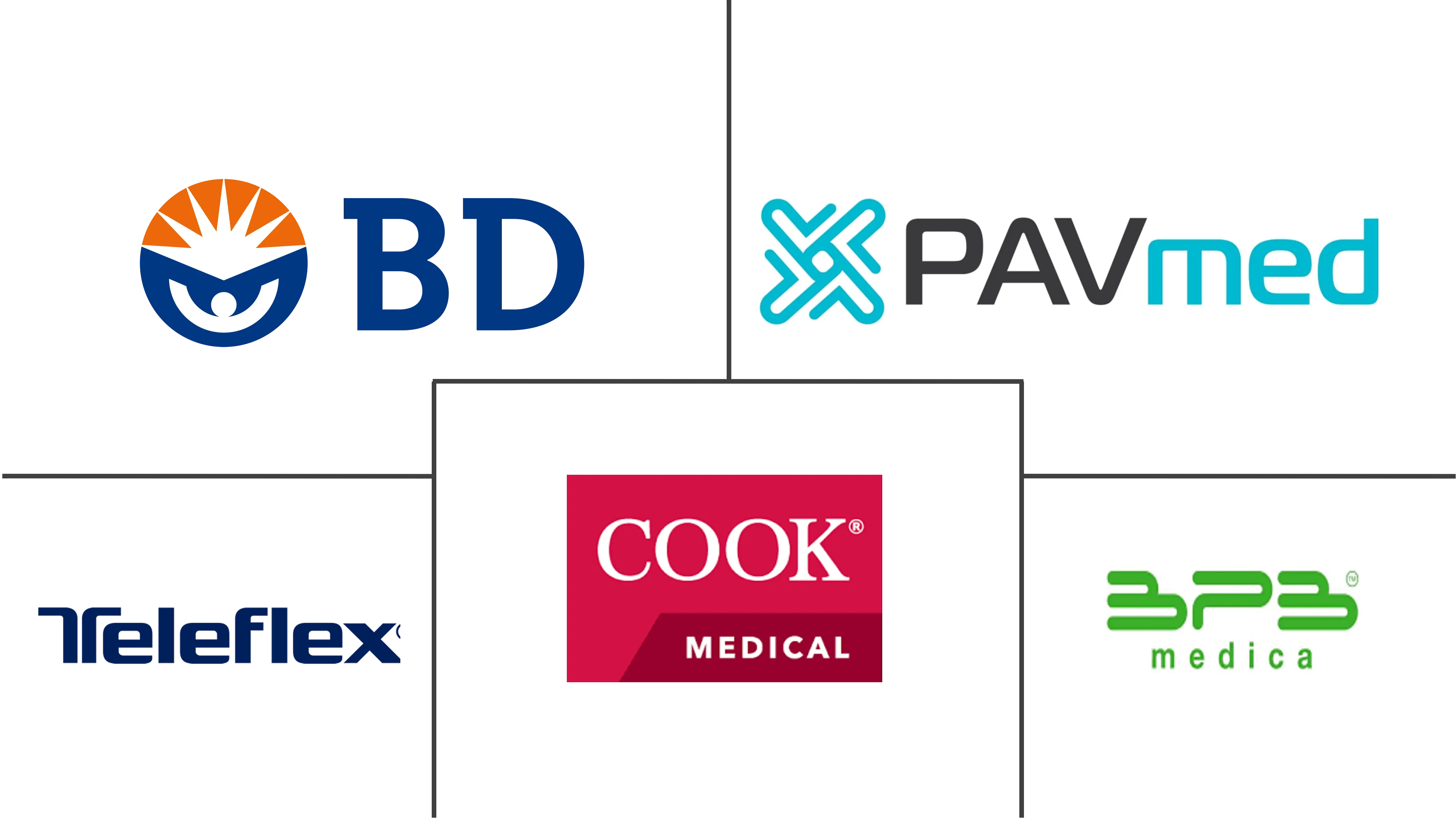Market Size of Intraosseous Infusion Kits Industry

| Study Period | 2019 - 2029 |
| Base Year For Estimation | 2023 |
| CAGR | 7.20 % |
| Fastest Growing Market | Asia Pacific |
| Largest Market | North America |
| Market Concentration | Medium |
Major Players
*Disclaimer: Major Players sorted in no particular order |
Intraosseous Infusion Kits Market Analysis
The intraosseous infusion kits market is anticipated to register a CAGR of nearly 7.2% during the forecast period.
- COVID-19 impacted market growth slightly due to the cancellations of elective procedures involving hospitalization other than COVID-19. However, the market growth recovered in the last few years since the restrictions were lifted. The new variants of COVID-19 have no significant impact on the studied market in the current scenario. Hence, the market is expected to register a stable growth rate during the forecast period.
- The advantages of intraosseous infusion (IO) over other routes of administration of drugs are expected to propel market growth. For instance, a research article published in the European Journal of Trauma and Emergency Surgery in February 2021 included nine studies comprising 1,218 trauma patients and 1,432 device insertions. The insertion success rate was 95%, and the incidence of complications was 0.9%. The article stated that intraosseous catheters have high insertion success rates and a low incidence of complications in trauma patients.
- Additionally, an article published in February 2022 by the National Center for Biotechnology Information (NCBI) stated that intraosseous infusion is an effective and safe technique, that increases patient survival. As a result, it is critical that all nursing professionals understand how to use the various intraosseous devices in situations where immediate peripheral venous access is not possible. The advantages and rising awareness about IO infusion are expected to propel the demand for IO infusion kits during the forecast period.
- Furthermore, the rising burden of arthritis and trauma is expected to propel the demand for IO infusion as these diseases are associated with difficulty in establishing venous access, which is made possible by the use of intraosseous needles. For instance, as per the Australian Bureau of Statistics 2023 update, one in eight (12.5%) people of all ages had arthritis in Australia in 2021. Additionally, as per versus arthritis 2022 report, 20.3 million people had a musculoskeletal (MSK) condition such as arthritis or back pain in the United Kingdom in 2021. Therefore, the high prevalence of arthritis worldwide is expected to propel the demand for IO infusion for the greater bioavailability of drugs for the treatment of diseases, thereby augmenting market growth.
- Therefore, owing to the aforementioned factors, such as the advantages of IO infusion and the high burden of arthritis worldwide, the studied market is anticipated to witness growth over the analysis period. However, the high cost associated with Procedures and stringent regulatory approvals and product recalls is expected to restrain the market growth.
Intraosseous Infusion Kits Industry Segmentation
Intraosseous infusion refers to injecting medication directly into the vascular system. The devices and kits used for this procedure are termed intraosseous infusion kits.
The intraosseous infusion kits market is segmented by device technology (battery-powered, manual, impact-driven), route of administration (distal femur, sternum, distal and proximal tibia, and other routes of administration), end users (hospitals, ambulatory surgical centers, other end users), and geography (North America, Europe, Asia-Pacific, Middle East and Africa, and South America). The report also covers the estimated market sizes and trends for 17 countries across major regions globally.
The report offers the value (in USD) for the above segments.
| By Device Technology | |
| Battery Powered | |
| Manual | |
| Impact Driven |
| By Route of Administration | |
| Distal Femur | |
| Sternum | |
| Distal and Proximal Tibia | |
| Other Routes of Administration |
| By End-Users | |
| Hospitals | |
| Ambulatory Surgical Centers | |
| Other End-Users |
| Geography | ||||||||
| ||||||||
| ||||||||
| ||||||||
| ||||||||
|
Intraosseous Infusion Kits Market Size Summary
The intraosseous infusion kits market is poised for steady growth, driven by the advantages of intraosseous infusion over other drug administration routes. This method is particularly beneficial in trauma situations where peripheral venous access is challenging, offering high insertion success rates and low complication incidences. The increasing prevalence of conditions such as arthritis and trauma, which complicate venous access, further fuels demand for these kits. Despite the high costs and regulatory challenges, the market is expected to expand as awareness and understanding of intraosseous devices grow among healthcare professionals. The hospital segment, in particular, is anticipated to experience significant growth due to the rising number of trauma and burn patients requiring immediate treatment.
North America is expected to lead the market, supported by a high burden of arthritis and trauma cases, substantial research and development investments, and a concentration of key market players. The region's focus on innovative intraosseous administration devices is likely to drive market expansion. The competitive landscape is characterized by a few major companies, including Aero Healthcare, BD, and Teleflex, among others, which hold significant market shares. Recent developments, such as successful clinical trials and strategic acquisitions, indicate ongoing advancements and consolidation in the market, promising further growth opportunities in the coming years.
Intraosseous Infusion Kits Market Size - Table of Contents
-
1. MARKET DYNAMICS
-
1.1 Market Overview
-
1.2 Market Drivers
-
1.2.1 Increasing Cases of Trauma and Arthritis
-
1.2.2 Advantages over Other Route of Drug Administrations
-
-
1.3 Market Restraints
-
1.3.1 High Cost associated with Procedure
-
1.3.2 Stringent Regulatory Approvals and Product Recalls
-
-
1.4 Porter's Five Forces Analysis
-
1.4.1 Threat of New Entrants
-
1.4.2 Bargaining Power of Buyers/Consumers
-
1.4.3 Bargaining Power of Suppliers
-
1.4.4 Threat of Substitute Products
-
1.4.5 Intensity of Competitive Rivalry
-
-
-
2. MARKET SEGMENTATION (Market Size by Value - USD)
-
2.1 By Device Technology
-
2.1.1 Battery Powered
-
2.1.2 Manual
-
2.1.3 Impact Driven
-
-
2.2 By Route of Administration
-
2.2.1 Distal Femur
-
2.2.2 Sternum
-
2.2.3 Distal and Proximal Tibia
-
2.2.4 Other Routes of Administration
-
-
2.3 By End-Users
-
2.3.1 Hospitals
-
2.3.2 Ambulatory Surgical Centers
-
2.3.3 Other End-Users
-
-
2.4 Geography
-
2.4.1 North America
-
2.4.1.1 United States
-
2.4.1.2 Canada
-
2.4.1.3 Mexico
-
-
2.4.2 Europe
-
2.4.2.1 Germany
-
2.4.2.2 United Kingdom
-
2.4.2.3 France
-
2.4.2.4 Italy
-
2.4.2.5 Spain
-
2.4.2.6 Rest of Europe
-
-
2.4.3 Asia-Pacific
-
2.4.3.1 China
-
2.4.3.2 Japan
-
2.4.3.3 India
-
2.4.3.4 Australia
-
2.4.3.5 South Korea
-
2.4.3.6 Rest of Asia-Pacific
-
-
2.4.4 Middle East and Africa
-
2.4.4.1 GCC
-
2.4.4.2 South Africa
-
2.4.4.3 Rest of Middle East and Africa
-
-
2.4.5 South America
-
2.4.5.1 Brazil
-
2.4.5.2 Argentina
-
2.4.5.3 Rest of South America
-
-
-
Intraosseous Infusion Kits Market Size FAQs
What is the current Intraosseous Infusion Kits Market size?
The Intraosseous Infusion Kits Market is projected to register a CAGR of 7.20% during the forecast period (2024-2029)
Who are the key players in Intraosseous Infusion Kits Market?
Cook Medical , PAVmed Inc. , BPB Medica - Biopsybell, BD (Becton, Dickinson and Company) and Teleflex (Pyng Medical) are the major companies operating in the Intraosseous Infusion Kits Market.

